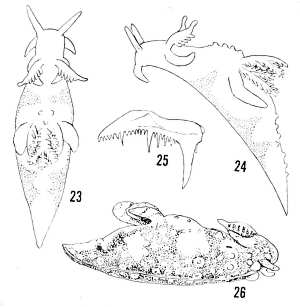
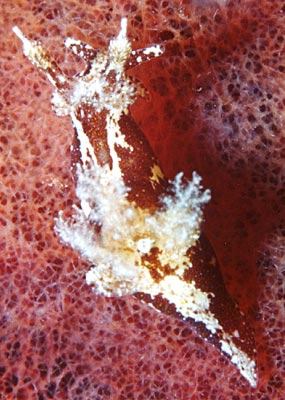
Trapania dalva
Marcus, 1972
Order: NUDIBRANCHIA
Suborder: DORIDINA
Superfamily: ANADORIDOIDEA
Family: Goniodorididae
DISTRIBUTION
Known only from Florida, and the Bahamas.
PHOTO
UPPER: Marcus, 1972: Figs 23-26 - original description.
LOWER: off Deerfield Beach, Florida, depth of about 40 feet. October, 2002. Photo: Judy Townsend.
This species was described from a single preserved specimen collected at Miami, Florida. The only colour information noted was 'The color was cream with white bosses and brownish blotches'. From the line drawing Fig 23 [copied above] of the preserved animal it appears that the brown areas [shaded in drawing] are quite extensive and the cream region forms a distinctive symmetrical pattern very similar to that shown in Linda Ianniello's and Judy Townsend's photos from Florida.
If these photos do prove to be Trapania dalva then its colour would best be described as dark brown with a symmetrical pattern of cream white blotches down the dorsal midline and a pair of diagonal lines running from the midline in front of the gills to the outside of the rhinophore pocket. The brown region is spotted with orange yellow, with white spots also being present down the sides of the body.
Reference:
• Marcus, Ev., 1972. On some Opisthobranchs from Florida. Bulletin of Marine Science, 22(2): 284-308.
Rudman, W.B., 2002 (March 4) Trapania dalva Marcus, 1972. [In] Sea Slug Forum. Australian Museum, Sydney. Available from http://www.seaslugforum.net/find/trapdalv
Related messages
Trapania dalva from St. Vincent
December 13, 2005
From: Les Wilk
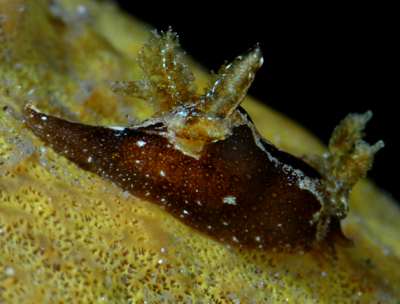
Hi Bill;
Here are a few more photos of Trapania dalva for your archive. We encountered many of them on yellow sponges during a night dive.
Locality: west coast, St. Vincent, Caribbean. Depth: 20 feet. Length: 0.25-0.50 inch. July 2005. on yellow sponge. Photographer: Keri Wilk
Les Wilk
wilk@reefnet.ca
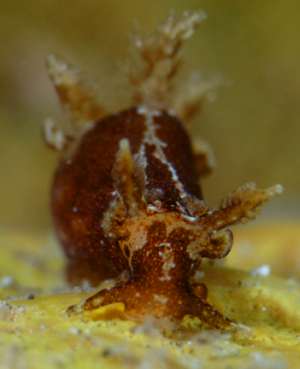
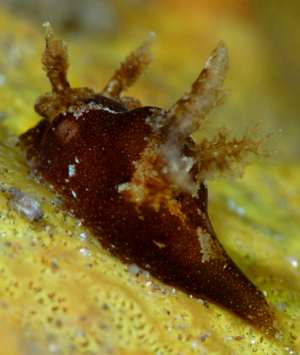

Dear Les,
It's nice to get another record of this small dorid. Species of Trapania are usually found on sponges, but we now know that their food is not the sponges, but small colonial animals called entoprocts which live in association with the sponges. I suspect the small translucent greyish objects in the front of the photo alongside are the small stalked entoprocts this animal eats.
Best wishes,
Bill Rudman
Trapania dalva? from St. Croix, Virgin Islands
April 15, 2005
From: Julie Edwards

I've looked through all the books I have to identify this little nudi.
I found it at the end of a dive I took in February, late in the evening at around 20.10. I had stopped at this particular sponge to take some pictures of Aphelodoris antillensis and as I was about to swim away when I noticed a "fleck" that had distinct rhinopores and gills. Since I was cold, tired, and low on air I only took two shots and one isn't in focus. The rhinopores in the image are out of focus. but where feathery and very light yellow or cream.
Locality: Cane Bay, north shore, St. Croix, US Virgin Islands, Caribbean Sea. Depth: 6 meters. Length: approximately a grain of rice, or about 7mm. 27 February 2005. Photographer: Julie Edwards
Thanks for the help in ID!
Julie Edwards
julie@in.ter.net
Edwards. J., 2005 (Apr 15) Trapania dalva? from St. Croix, Virgin Islands. [Message in] Sea Slug Forum. Australian Museum, Sydney. Available from http://www.seaslugforum.net/find/13460Dear Julie,
This is the animal I have identified previously as Trapania dalva, but if you have a look at the discussion in the attached messages you will see that there is some doubt surrounding that idenitification. Unfortunately no clear colour description was included in the original description of the species and we don't know enough about Caribbean nudibranchs to know just how variable this species is in colour.
Best wishes,
Bill Rudman
Re: Trapania dalva - juvenile?
November 1, 2002
From: Juan Lucas Cervera
Dear Bill,
Concerning Linda's possible juveniles. In my earlier message I mentioned our publication of the description of a new species of Trapania, and also include some remarks on some uncommon Atlantic species of this genus, with a color plate of several Atlantic species of the genus. One of these uncommon species was Trapania dalva. Colin Redfern send me a small animal from Bahama, a photo of which is in the color plate. The color pattern of this animal was lighter, and the reproductive system was not mature.
Lucas.
lucas.cervera@uca.es
Cervera, J.L., 2002 (Nov 1) Re: Trapania dalva - juvenile?. [Message in] Sea Slug Forum. Australian Museum, Sydney. Available from http://www.seaslugforum.net/find/8331Thanks Lucas,
This would support the suggestion that Linda's animals are juveniles
Best wishes,
Bill Rudman
Trapania dalva - juvenile?
October 31, 2002
From: Linda Ianniello
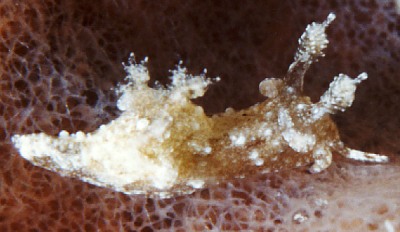
Dr. Bill,
To go along with my other message about Trapania dalva we found on a recent night dive (October 2002 off Deerfield Beach, Florida, at a depth of 40'), we also saw quite a few of what appeared to be juveniles. They were much smaller than the brown ones, and an off-white color (not brown). In one location I saw approximately 6 of these smaller ones within a 12-inch area of one of the larger ones. In other locations the tiny ones were by themselves. The attached photo was taken by my friend Judy Townsend, who had the right size framer and got a good shot of one.
Regards,
Linda I.
lindai@us.ibm.com
Ianniello, L., 2002 (Oct 31) Trapania dalva - juvenile?. [Message in] Sea Slug Forum. Australian Museum, Sydney. Available from http://www.seaslugforum.net/find/8265Thanks Linda & Judy,
This is another interesting find as this animal has much the colour of the ones illustrated by Colin Redfern from the Bahamas, whic I commented on in your earlier message. It is of course possible that the little ones are a different species. I tend to lean towards the simplest suggestion, which is that these are juveniles of T. dalva which have yet to develop their brown pigmentation. If you are lucky, you might some time come across some intermediates in size and colour
Best wishes,
Bill Rudman
Trapania dalva - Better Shots
October 30, 2002
From: Linda Ianniello
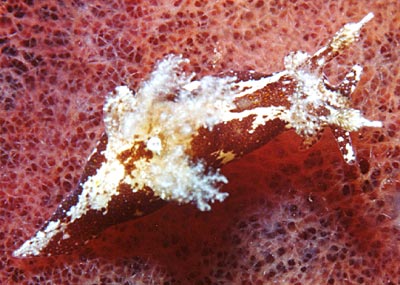
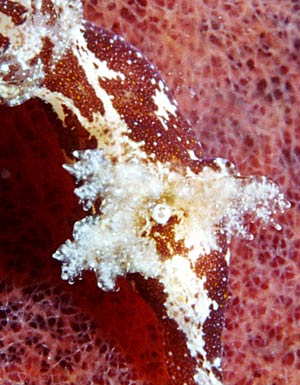
Dr. Bill,
Enclosed are two photos of Trapania dalva which are better than my original submission. They were found again October, 2002, on a night dive off Deerfield Beach, Florida, at a depth of about 40 feet. Luckily my friend Judy Townsend had the right size framers to get better shots; these are her photos. The first is a shot of the whole animal, and barely shows the lateral process you were looking for alongside the gills. The second is a better shot showing the lateral process.
Regards,
Linda I.
lindai@us.ibm.com
Ianniello, L., 2002 (Oct 30) Trapania dalva - Better Shots. [Message in] Sea Slug Forum. Australian Museum, Sydney. Available from http://www.seaslugforum.net/find/8264Dear Linda & Judy,
Thanks for these photos and for confirming the presence of the lateral processes. I am more convinced than before that this is Marcus' Trapania dalva, although the anatomy will need to be looked at, or at least the radula. I have looked again at the photos and the description of the animal Colin Redfern has identified from the Bahamas as T. dalva (Redfern, 2001) and I suspect it is a pale colour form of the same species, but again their anatomy would need to be compared,
Best wishes,
Bill Rudman
Re: Trapania dalva from Florida
March 7, 2002
From: Juan Lucas Cervera
Hi Bill,
In my paper (with Garcia-Gomez and Megina): "A new species of Trapania Pruvot-Fol, 1953 from the Bay of Cadiz, with remarks on other Trapania species" [Ophelia, 52(1): 17-24], I included a photo of T. dalva from the Bahamas supplied by Colin Redfern. However, Linda's animal seems to me different than the animal that I enclosed in my colour plate. This species is very uncommon and I don't know the degree of colour variability of it.
Regards.
Lucas.
lucas.cervera@uca.es
Cervera, J.L., 2002 (Mar 7) Re: Trapania dalva from Florida. [Message in] Sea Slug Forum. Australian Museum, Sydney. Available from http://www.seaslugforum.net/find/6383Thanks Lucas,
I agree that my identification is doubtful. Firstly is Linda's animal a Trapania? I am pretty sure there are lateral processes alongside the rhinophores but not so sure if they occur by the gills. Obviously a look at the radula would be useful.
If it is a Trapania, the next problem is identifying Marcus' species. The original description does not give a very clear description of the external colour pattern and it could fit both Linda's photos and Brian Redfern's photos from the Bahamas. Perhaps the species is variable in colour. Obviously the radula of the two 'species' need to be compared with each other and with Marcus's description.
Just another of life's little problems
Cheers,
Bill Rudman
Trapania dalva from Florida
March 5, 2002
From: Linda Ianniello

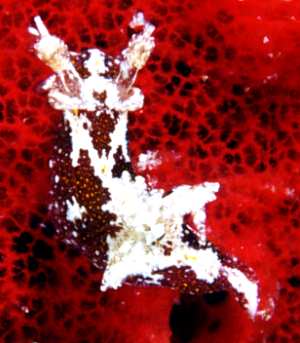
Hi, Bill.
Here are two shots of a nudibranch I can't identify, that maybe you can help with. The edges all seem to be white and fuzzy ..... it is not crisp and clean like some others. It is very small; these shots are 2:1 and cropped, and still not very good I'm afraid. I've only found it a couple of times, at night, on the reef off Delray Beach, Florida, at a depth of about 55'.
I sent the shots to Colin Redfern and Sandra Millen, and they think it is from the family Polyceridae and appears to be a Polycera sp or a Palio.
Thanks for any help with the identification!
Regards,
Linda I.
lindai@us.ibm.com
Ianniello, L., 2002 (Mar 5) Trapania dalva from Florida. [Message in] Sea Slug Forum. Australian Museum, Sydney. Available from http://www.seaslugforum.net/find/6380Dear Linda,
I think this is probably Trapania dalva. It's hard to be sure but I'm pretty convinced I can see a curved lateral process on the outside of each rhinophore but I am not so sure about the ones alongside the gills. Colin Redfern describes a specimen from the Bahamas in his book and I can see nothing in that description which precludes your animals and his being the same species. he talks of many white and some orange spots in the brown regions of the body.
Another reason I think your animal is probably a species of Trapania is that in both your photos it is on a sponge, which is a common place to find speies of Trapania, not because they feed on the sponge but because they almost certainly feed on entoprocts which live in association with the sponge.
If you can check out your photos to see if there are any signs of recurved lateral processes alongside the gills it would help clarify the situation. I have been posting a lot of messages about species of Trapania in the last couple of days, so have a look at them to see the shape of the lateral processes.
Best wishes,
Bill Rudman
